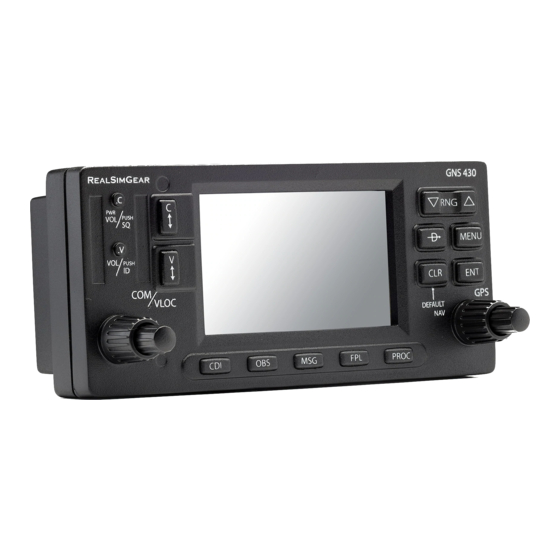Screen Layout / CURSORs / Frequency Selection
Screen Layout (windows)
{
COM Window
{
VLOC Window
The GNS 430's display is divided into three separate "windows" (or
screen areas). The left 1/4 of the display provides a COM window (top two
lines) and a VLOC window (bottom two lines) The right 3/4 of the display
consists of a GPS window, which is where you'll find the various navigation,
waypoint information and settings "pages".
Each unique screen of information is referred to as a page. Pages are
typically selected using the small ( a ) and large (
cursor removed from the GPS window. See the following page for details
on arrangement of the GNS 430's main pages.
Cursors
There are two separate cursors: a tuning cursor and a GPS window
cursor. The tuning cursor is used to select the standby COM or VLOC
frequency. If desired, press the small left knob ( v ) to move the tuning
cursor to the VLOC window. Then, use the small ( f ) and large (
knobs to select the desired frequency. The COM (
4
flop keys are used to activate the selected frequency.
Active Frequency on top &
Standby on bottom
(highlighted by cursor)
}
GPS Window
d
) right knobs—with the
h
) left
W
V
) and VLOC (
) flip-
Frequency Selection
1. If the tuning cursor is not currently in
the desired window (COM or VLOC),
press the small left knob
momen-
( v )
tarily.
h
2. Rotate the large left knob (
) to
select the desired megahertz (MHz)
value. For example, the 117 portion
of the frequency 117.80.
3. Rotate the small left knob
to
( f )
select the desired kilohertz (kHz)
value. For example, the .80 portion
of the frequency 117.80.
4. To activate the selected frequency,
press the corresponding flip-flop
W
key
for COM frequencies or
for VLOC frequencies.
Data Entry
Data is entered in the GPS win-
d
dow using the large (
) and small
( a ) right knobs. The large right
d
knob (
) is used to move the cursor
about the page. The small right
knob ( a ) is used to select individual
characters for the highlighted cursor
location (see illustration).
V

